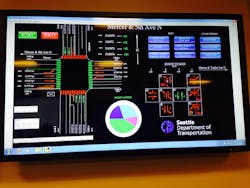TRAFFIC MANAGEMENT: Seattle deploys adaptive traffic-control system along congested corridor
As part of its intelligent transportation systems program, the city of Seattle has introduced a UK-developed adaptive traffic-control system to help reduce congestion along one of its busiest corridors.
The Seattle Department of Transportation (SDOT) has introduced the new Split Cycle Offset Optimization Technique (SCOOT) adaptive control system along Mercer Street between 3rd Ave W and I-5, with the technology coordinating the operation of the traffic signals in and around the corridor to help vehicles move more efficiently. The system adapts to varying traffic conditions, such as congestion that may result from sports events, concerts or hour-to-hour traffic volume changes in the area. Originally developed by the UK’s Transport Research Laboratory (TRL), SCOOT is an adaptive Urban Traffic Control (UTC) system that is now in use in over 250 towns and cities worldwide.
SCOOT automatically adjusts intersection signal timings to adapt to traffic conditions in real time, using data gathered from multiple vehicle sensors within clusters of road crossings called ‘regions,’ and is used to predict crossing timing decisions throughout each sector.
SCOOT’s benefits include reliable travel times through the network; enhanced transit operations; reduced overall emissions and fuel consumption; and being especially effective in situations in which traffic fluctuates due to special circumstances and/or special events.
In Seattle, a total of 32 signalized intersections are operational with SCOOT along Mercer Street and the parallel corridors of Valley/Roy St and Republican St. To assess how well SCOOT is working, SDOT has been collecting vehicle data on a daily basis and comparing it with historical averages. Reporting periods include morning and evening peak travel times (three hours) in both the eastbound and westbound directions during the five-day working week, when traffic volumes are at their highest. The agency has been testing it for the last month, and results are positive. In the eastbound direction, during the three-hour evening peak period, drivers are moving an average of 2.7 minutes faster and experiencing a 38% increase in travel-time reliability.
